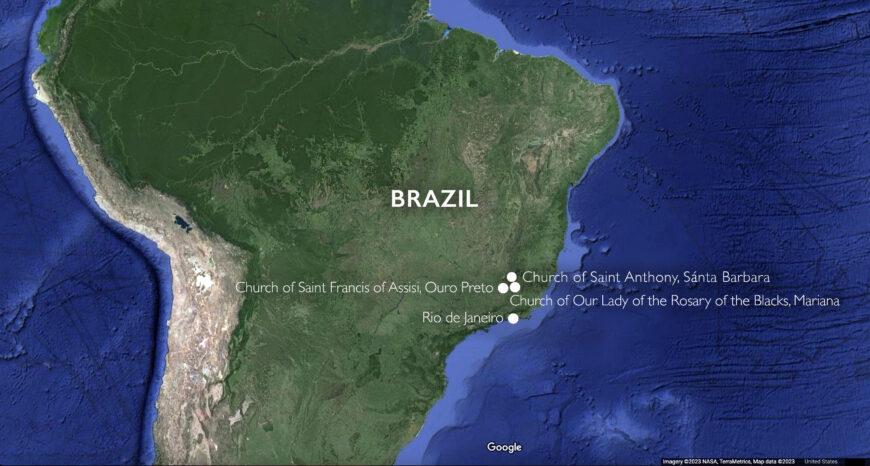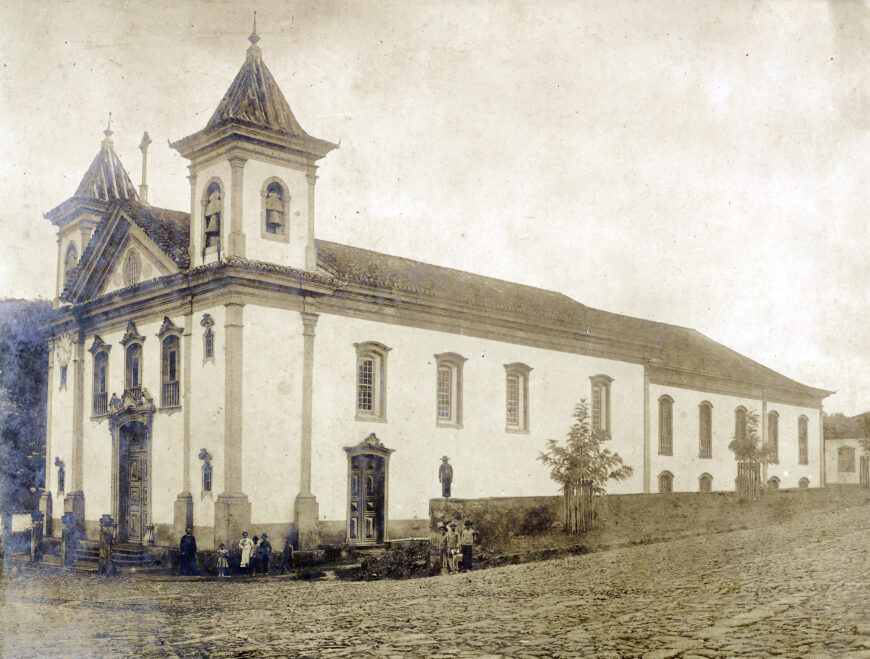
Unidentified photographer, Church of Saint Anthony, Santa Bárbara, Brazil, c. 1900 (Arquivo Nacional, Brazil)
In 1818, Manoel da Costa Ataíde wrote a letter to John VI, the King of Portugal, Brazil, and the Algarves, requesting permission to offer drawing and painting courses in Mariana, his hometown in Brazil. Ataíde, who was born in Brazil to Portuguese parents, proposed that he could teach “useful” arts: “Geographic and topographic cartography, and the drawing and painting of animals, plants, birds, and other products of nature.” Members of Mariana’s city government also signed the letter attesting to Ataíde’s qualifications and other documents describe him as “professor of the art of painting.” Although scholars don’t know if the king responded and whether the courses ever materialized, Ataíde was a successful painter in the region. He completed many large-scale commissions and is most well-known for his ceiling paintings.
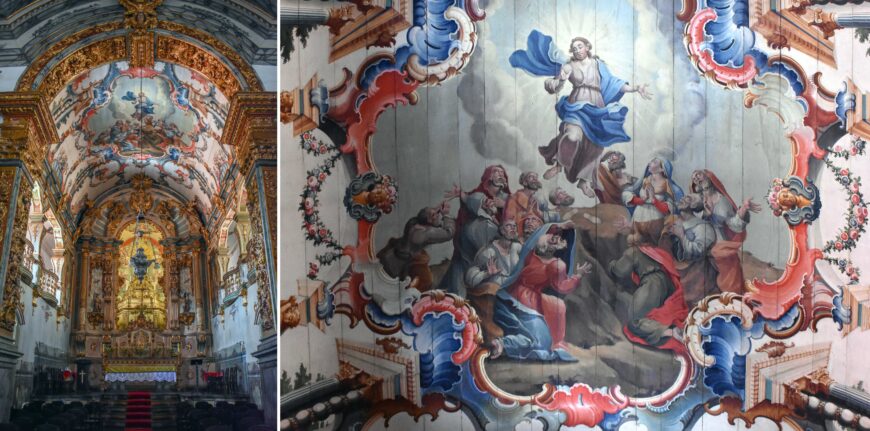
Left: View of the chancel, Church of Saint Anthony, Santa Bárbara, Brazil (photo: courtesy of Bruno Simões Coelho, all rights reserved); right: Manoel da Costa Ataíde, The Resurrection (chancel ceiling), completed by 1822, Church of Saint Anthony, Santa Bárbara, Brazil (photo: courtesy of Bruno Simões Coelho, all rights reserved)
Church of Saint Anthony, Santa Bárbara
Examples of Ataíde’s ceiling paintings survive in the Church of Saint Anthony in the town of Santa Bárbara, as well as several other cities in the gold mining region of colonial Brazil (examples include the Church St. Francis of Assisi, Ouro Preto and the Sanctuary of Bom Jesus de Matosinhos). The ceiling of the Church of Saint Anthony in Santa Bárbara is composed of two parts:
- Image above: in the chancel (in front of the main altar, where priests and others participated in Mass), we see the Resurrection. Jesus lifts off from a rock, leaving his footprints behind, with his disciples watching in awe.
- Image below: in the nave (the main space of the church), we see the Virgin Mary rising to heaven. Since she is not herself divine, she cannot float to heaven unassisted but instead sits on a cloud that angels push toward heaven. Her empty tomb is on the ground below.
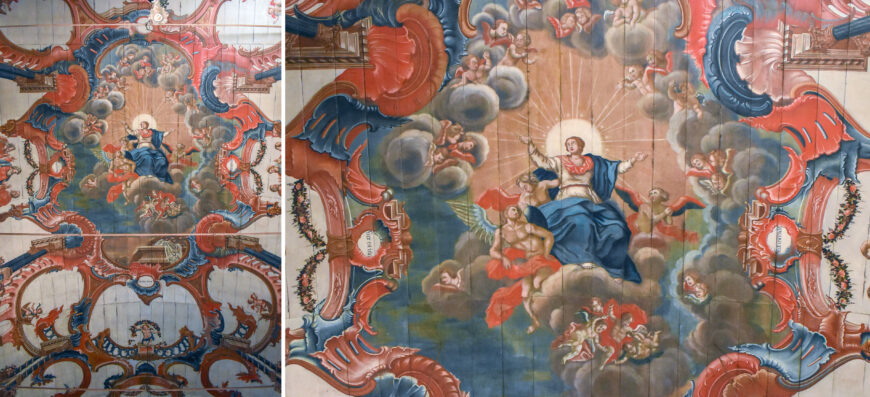
Manoel da Costa Ataíde, Assumption of the Virgin Mary (nave ceiling), Church of Saint Anthony, Santa Bárbara, Brazil, completed by 1822 (photo: courtesy of Bruno Simões Coelho, all rights reserved)
The ceiling paintings at Santa Bárbara mix an illusion that the ceiling has disappeared and the heavens are visible with whimsical rococo ornament. Two hundred years earlier, the Church of Il Gesù in Rome popularized similar ceiling paintings that created the illusion that architectural elements were opening up and miraculously displaying holy figures in heaven. In Brazil, such majestic architectural illusions were also popular, as seen in ceiling paintings by José Joaquim da Rocha who worked in the Northeast of Brazil.
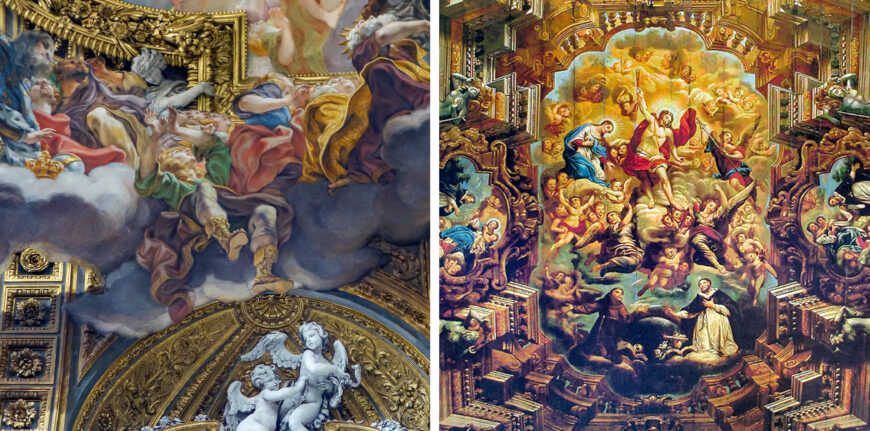
Left: foreshortened figures (detail), Giovanni Battista Gaulli, The Triumph of the Name of Jesus, 1672–85, ceiling fresco, Il Gesù, Rome (photo: Steven Zucker, CC BY-NC-SA 2.0); right: figures parallel to the picture plane (detail), José Joaquim da Rocha, Ascension of Saint Dominic, 1781, ceiling of the church of Third Order of Saint Dominic, Salvador, Brazil
However, artists in Brazil (like da Rocha) placed the figures parallel to the picture plane, instead of foreshortening them (as we see on the ceiling in Il Gesù). This shift in perspective makes the painting more legible, letting viewers identify who is present and what is happening more easily.
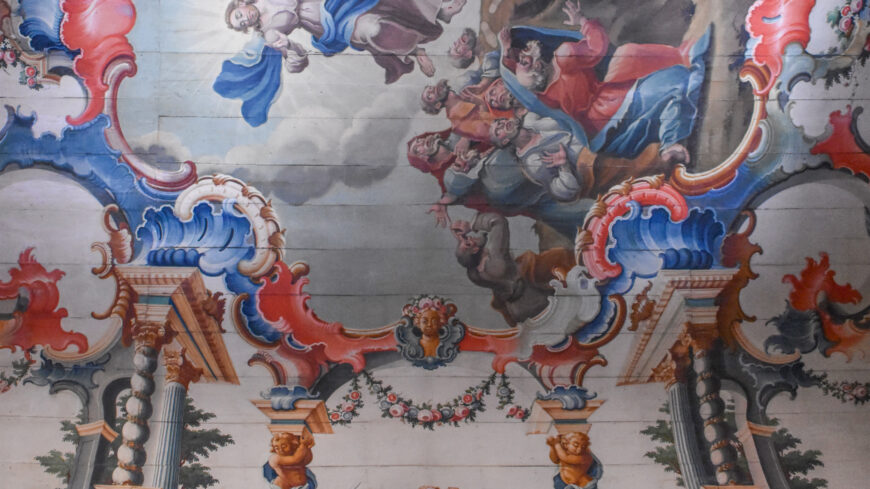
Solomonic columns and atlantes supporting the pictorial frame containing the Resurrection (detail), Manoel da Costa Ataíde, The Resurrection (chancel ceiling), completed by 1822, Church of Saint Anthony, Santa Bárbara, Brazil (photo: courtesy of Bruno Simões Coelho, all rights reserved)
Ataíde’s designs in Santa Bárbara likewise feature foreshortened painted architectural supports surrounded by heavenly figures floating amid clouds. Unlike the sturdy pilasters and columns in da Rocha’s paintings, however, Ataíde’s architectural supports appear decorative. The curving atlantes with their individualized movements and facial expressions, and the combinations of fluted columns, spiraling Solomonic columns, and square piers are reminiscent of decorative details found on façades for ornamental effect rather than structural integrity. In addition, these painted architectural elements are supporting an exuberant pattern of rocailles instead of more architecture.
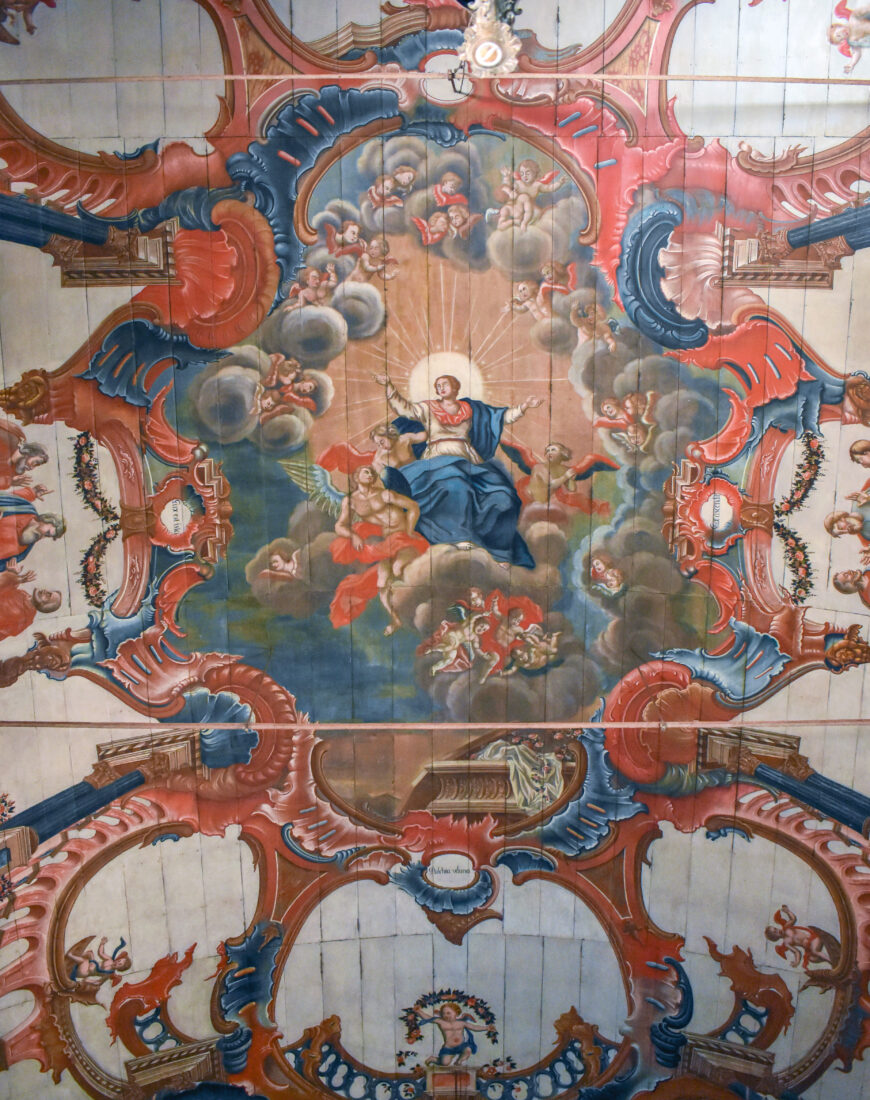
Manoel da Costa Ataíde, Assumption of the Virgin Mary (nave ceiling), Church of Saint Anthony, Santa Bárbara, Brazil, completed by 1822 (photo: courtesy of Bruno Simões Coelho, all rights reserved)
Church of Our Lady of the Rosary of the Blacks in Mariana
Numerous chapels and churches throughout this region of Brazil feature ceilings with this type of design—an option that could be specified in the contract. For instance, the contract for another of Ataíde’s commissions in the church of Our Lady of the Rosary of the Blacks in Mariana states: “After being white-washed, the ceiling of the chancel shall be drawn and painted with an elegant and modern perspective, with fine colors of the best taste and bravura and in the central area of that painting a panel representing the Assumption of the Virgin, or what fits better, ornamented, and accompanied with seraphims and angels.” This contract dictates the overall design (a perspectival illusion surrounding a central panel) and the iconography (the Assumption of the Virgin with angels) but leaves details of the composition and style to the artist as long as the patrons considered the result elegant, modern, and of the highest quality.
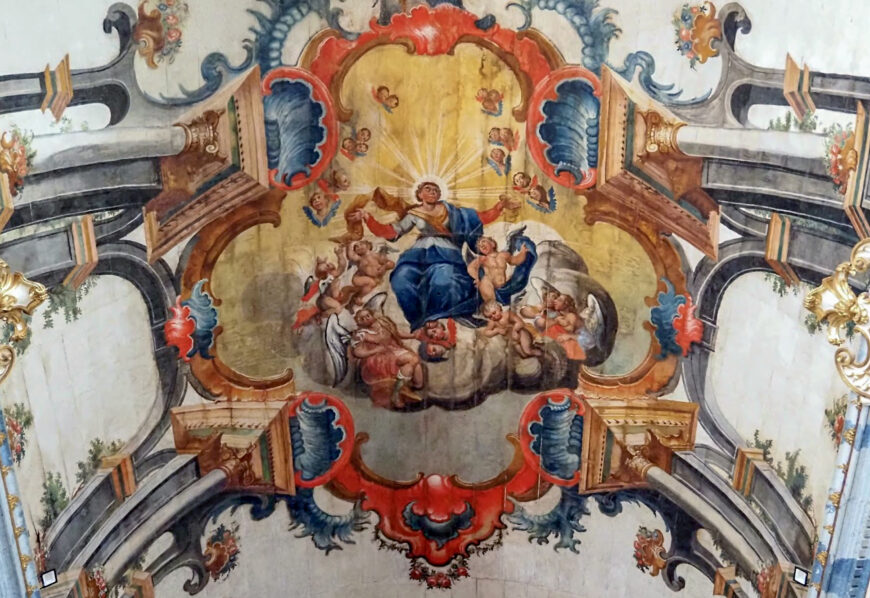
Manoel da Costa Ataíde, chancel ceiling painting, Church of Our Lady of the Rosary of the Blacks in Mariana, c. 1823–26 (photo: courtesy of Miguel Valerio, photographed June 2022, all rights reserved)
In this case, the patrons were officers of the Black brotherhood of Our Lady of the Rosary. Ataíde probably provided suggestions while the officers made the final decisions about the ornamentation of the church. In the case of this commission, the patrons were not satisfied with the work. Some areas were gilt with silver instead of gold, and some of the work was considered of poor quality. As a result, the patrons withheld payment and Ataíde sued the brotherhood. Third parties were called in to inspect the work. With expensive, large-scale projects that involved multiple teams of workers, contracts and inspectors protected the patrons as well as the artists.
View of the nave, Church of Saint Anthony, Santa Bárbara, Brazil
What are we seeing?
Close looking at several of Ataíde’s paintings reveals differences in style and color scheme largely due to the deterioration that comes after 200 years. Today, the individual slats of wood that make up the painted ceilings are often visible due to fluctuations in temperature and humidity that have caused the wood to expand, shrink, and warp. Thanks to conservation efforts, other deterioration is less obvious but the paintings look somewhat different now than they did originally. The ceilings in Santa Bárbara are relatively well-preserved; however, the chancel ceiling in the Church of Our Lady of the Rosary of the Blacks in Mariana has lost significant amounts of paint to water damage. What is visible today is the result of an extensive conservation project from 2016 to 2022.
View of the chancel, Church of Saint Anthony, Santa Bárbara, Brazil
The famous ceiling painting by Ataíde of the church of Saint Francis of Assisi in Ouro Preto has also changed over the years. Restorers, chemists, and art historians participated in the ceiling’s conservation from 1985 to 1988. The teams found that some sections had been overpainted, that the Prussian blue in some of the rocailles had turned ochre due to a chemical reaction, and that the central area was covered in a layer of brown dust and darkened varnish. The restorers removed the varnish, brown dust, and overpainting, but left the ochre color in the rocailles undisturbed to avoid damaging the painting. The goal was to balance protecting the original artwork and approaching the original appearance as closely as possible.
Who did the work?
Another reason for the differences in appearance between the various ceiling paintings is that they were probably created by different people. In the church in Santa Bárbara for instance, art historians believe that Ataíde painted the chancel ceiling himself whereas his workshop painted the nave ceiling. This was a common practice. Master artists trained apprentices and hired journeymen. Once these young artists and assistants had learned the master artist’s style well, they could be asked to complete all or part of an artwork. Ataíde was responsible for ensuring that their work met his standards and for adding finishing touches, if necessary.
Records from Brazil at this time do not usually include who was part of a master’s workshop. The lawsuit about the work on the chancel of the church in Mariana, however, provides a list of names. According to the trial records, Ataíde had only spent a short time at the church and then left to work on a commission in a nearby town. Presumably, this means that most of the work was carried out by the mixed-race journeyman Jose Joaquim do Couto, Ataíde’s teenaged mixed-race son Francisco de Assis Pacifico da Conceição, an apprentice named Raimundo whose race is not listed, and two Black artists, Lucas and Matheus, who were enslaved by Ataíde, and who were aged fifteen and twenty-three when the project began in 1823. Some or all of these artists are likely to have also worked on Ataíde’s other commissions, including the nave ceiling in Santa Bárbara that is attributed to his workshop. Afro-Brazilian artists are crucial to Brazil’s cultural heritage not only as assistants to a white artist as in this church, but also as master artists taking on their own contracts, such as Antonio Francisco Lisboa, Mestre Valentim, and Teofilo de Jesus. [1]
Fame, history, and memory
Artworks associated with Manoel da Costa Ataíde involved patrons, assistants, apprentices, and enslaved artists. Ataíde’s name is well-known within the local communities that are proud to have his work in their churches, yet most community members are unaware of his actions as an enslaver and the role of artists of African descent in the creation of those artworks. Today, people often think of art as a means for the artist to express themself. We often think about an artist as someone who works alone, choosing what to make, how it will look, and what its message will be. This idea can lead to misconceptions, especially when looking at large, expensive projects like the ceiling paintings of the Church of Saint Anthony, Santa Bárbara.

